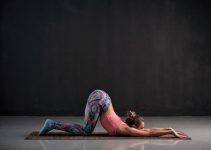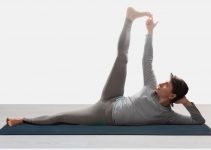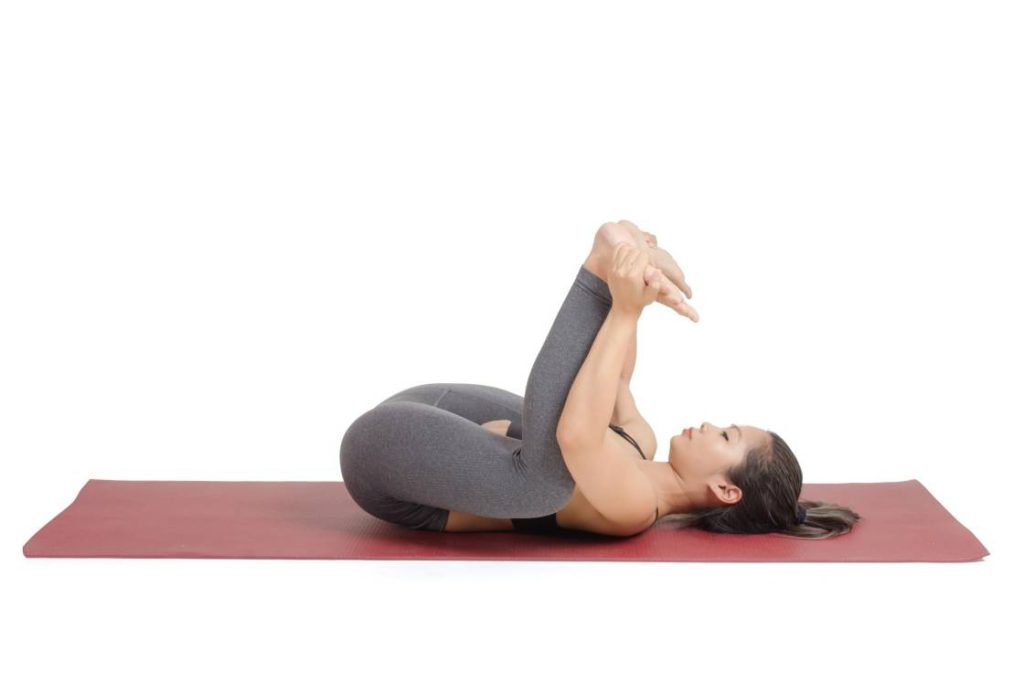
Happy baby pose is all about finding a yogic way of drawing attention towards the hips joints. This posture is a beginner level great hip-opener and solution to all the low back issues.
Assume the pose by lying down in the supine pose with bent knees. Lift the feet off the floor opening the knees outwards slightly wider than the torso. Hold the outer edge of the flexed feet with respective hands drawing the knees towards the armpits.
Besides relaxing the back, the Happy baby pose focuses and stretches the hamstrings, groins, shoulders, and chest muscles. It opens the hips, calms the mind, and brings joy.
Meaning
Ananda Balasana is a Sanskrit name for this pose. Here, “ananda” refers to “happiness” and “Bala” means “child, and “asana” is “pose”. Combining root terms meaning, In English, it is translated as a happy baby pose.
The fact that the body mimics a happy baby’s posture explains its name as a happy baby pose or blissful baby pose. Alternatively, all the four limbs away from the body against the gravity resemble a dead bug, hence named appropriately.
Ananda balasana is described in the Hatha yoga texts. It has been described under Sritattvanidhi as Kandukasana (Ball Pose) in the 19th century.
Mythological Significance
The tale of King Dashratha and his three wives longing for their child (Happiness) is attributed to ananda balasana.
For this, Dashratha performed a special yajna (sacrifice) called Ashwa Medha. Ashwa refers to “now” and “medha is “purification”. As a result of this, a golden vessel filled with pudding emerged out of the sacred fire. Dashratha shared the pudding with his wives, as he was ordered to and all his wives became pregnant.
Here, Dashratha represents the yogi, as “Dashratha” means “the one who controls mind and senses”. His eldest wife was “Kaushalya” refers to “skill”.
Therefore, when Dashratha performed the sacrifice and shared its results with Kaushalya, Rama was born. “Rama” means “the one who gives happiness”.
The union of Dashrath and Kaushalya after the sacrifice (Ashwamedha Yajna) represents “yoga“, i.e. to control the mind and senses at the present with the purification of thoughts. When this is shared with skill, then it results in inner radiance or happiness.
Inner radiance and joy (Rama) are always accompanied by three other qualities. These are mindfulness (Lakshman), friendship or no rivalry (Shatrughna), and talent (Bharat).
This sums up the pursuit of inner joy by controlling the senses and mind with skill, i.e. ananda balasana.
Happy Baby Pose(Ananda Balasana) Practice Guide
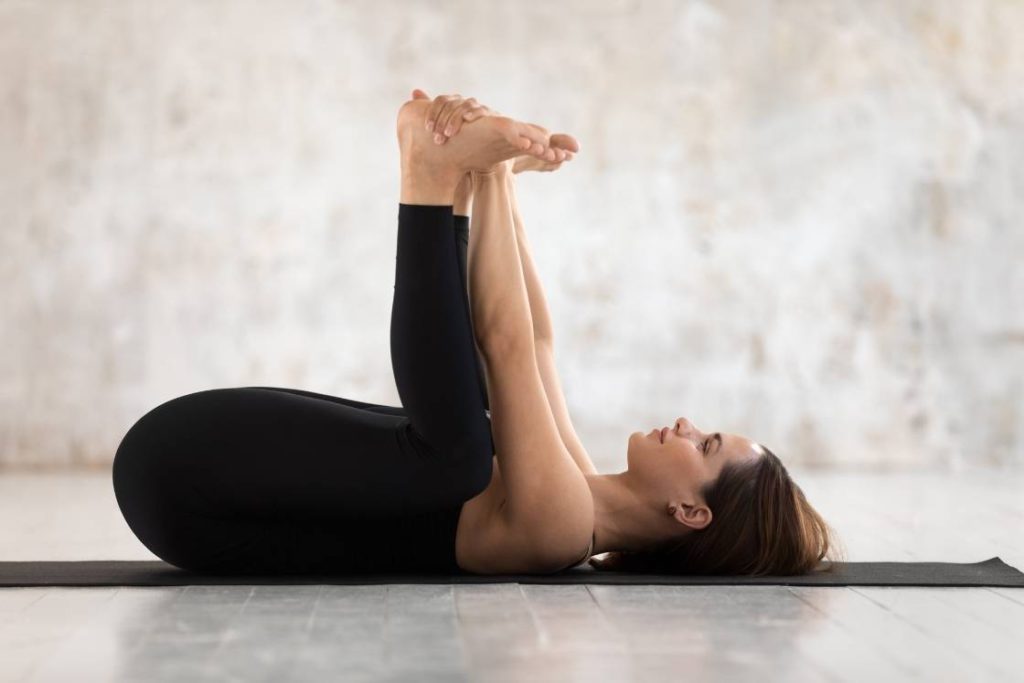
Contraindications
- Do not practice Happy Baby Pose during pregnancy or menstruation.
- Avoid this pose if there is any injury in the knees or ankles.
- Also, do not try this pose with an injury in the neck and shoulders.
Preparatory poses
How to Do Happy Baby Pose (Steps)
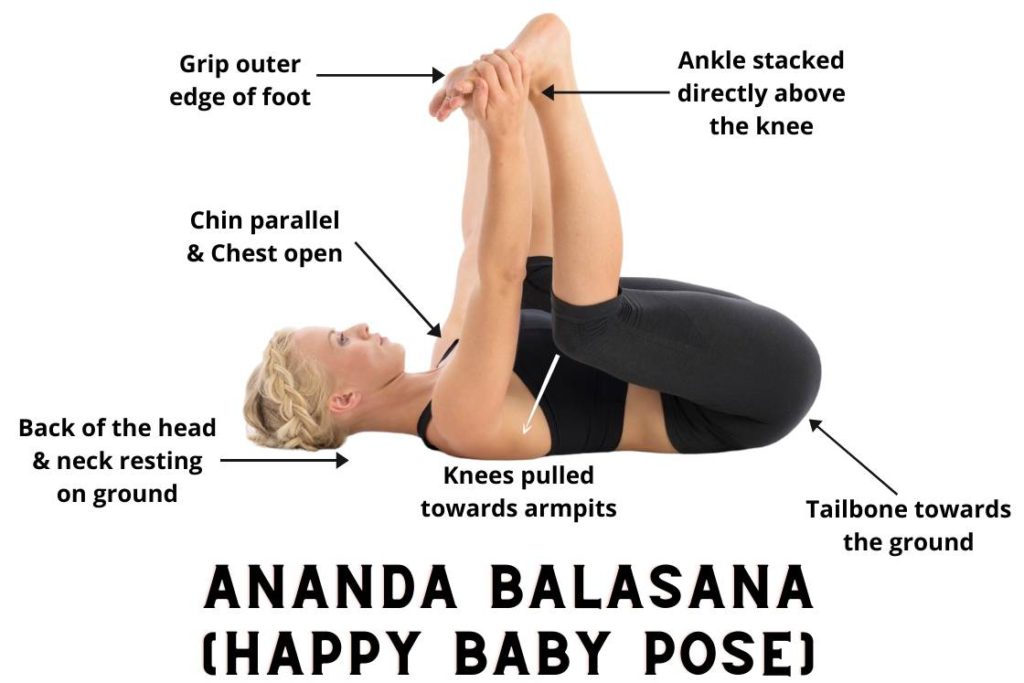
- Lie on your back bending the knees and placing the feet on the floor.
- Inhale, lift the legs and draw the knees towards the armpits opening the legs wider than the torso.
- Bring your arms between your knees to hold the outer edge of the feet.
- Keep the knees bent, tuck the chin into the chest, and rest your head on the floor.
- You can try rolling on the backside to the side or rocking the body back and forth.
- Hold the pose pressing the tailbone to the floor and flexing the feet for 30 to 60 seconds.
- Exhale, release the arms and legs to the floor.
- Relax the body in savasana.
Precautions
Happy Baby Pose(Ananda balasana) is a beginner-level posture, still, it is indispensable to keep the following details in mind to prevent any injury.
- Avoid arching the tailbone by pressing it consciously to the floor.
- Ensure that the ankles are aligned over the knees.
- Rocking the body back and forth is optional and refrain from this step if there is any strain in the neck.
Follow-up Poses
Downward-Facing Dog (Adho Mukha Svanasana)
Props and Modifications
Using the following modifications, one can enhance the opening of the hip joint in happy baby pose;
- Yoga strap – If it’s not possible to reach the feet keeping the spine straight on the floor, wrap a yoga strap around the feet. Hold onto the strap ends to maintain the pose experiencing stretch and relaxation.
- Against a wall – While keeping the feet flexed in the final pose press the heels against the wall. It will provide extra support to hold the pose for longer.
- Bolster – Keep a bolster between the knees while bringing the knees towards the body. It will keep the legs widened than the torso and opens the hips fully.
- Pillow – Keep a pillow under the neck while performing the pose. This pose is beneficial for those who have any strain on the neck. Using the pillow under the neck will make it easier to hold the pose.
Variations
These variations can be performed to introduce extra stretches and more movement in the happy baby pose;
1. Happy Baby Pose Holding the toes
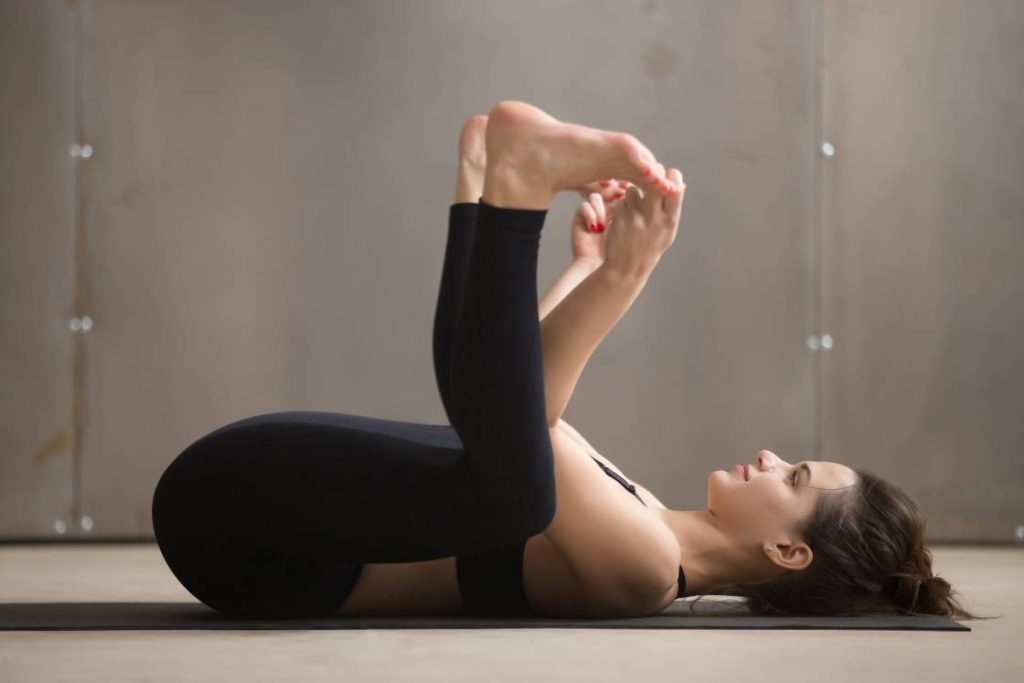
Perform the pose wrapping the thumb, index, and middle fingers around the big toes rather than holding the feet. This variation is preferred by beginners. Holding the toes is more approachable than holding the outer edge of the feet.
2. Happy Baby Pose One leg at a time
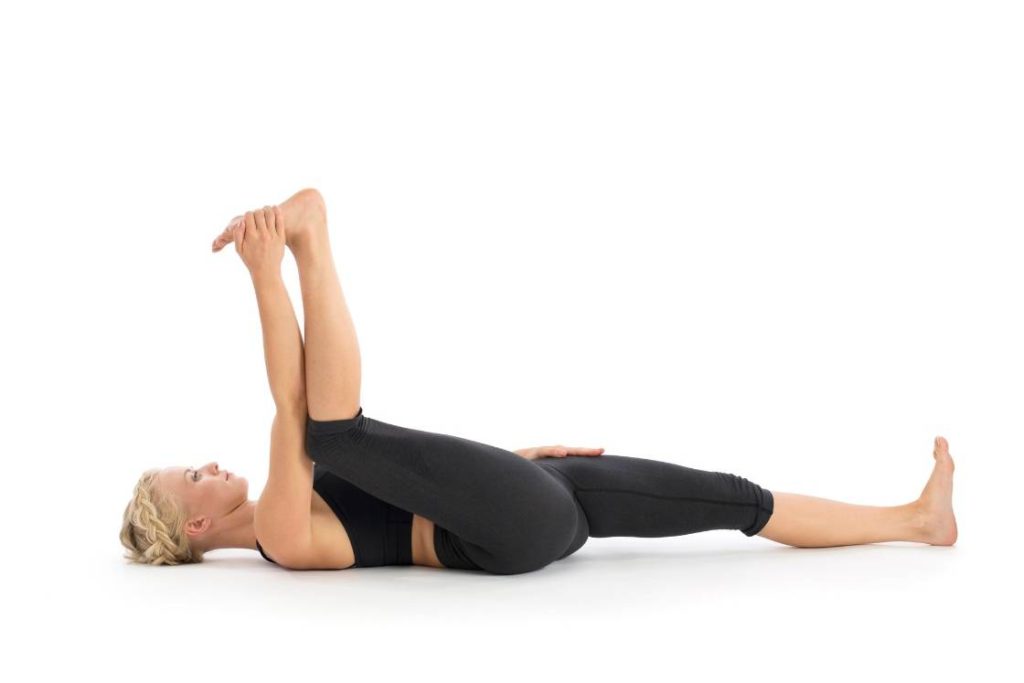
This is an easier variation where one leg lies flat on the floor. However, the alternate knee is drawn towards the shoulder. Hold the outer edge of the feet bringing the corresponding hand from the inner side of the knee. Keeping the feet flexed extend the lower leg up to the ceiling.
3. Happy Baby Pose Crossing the Elbows
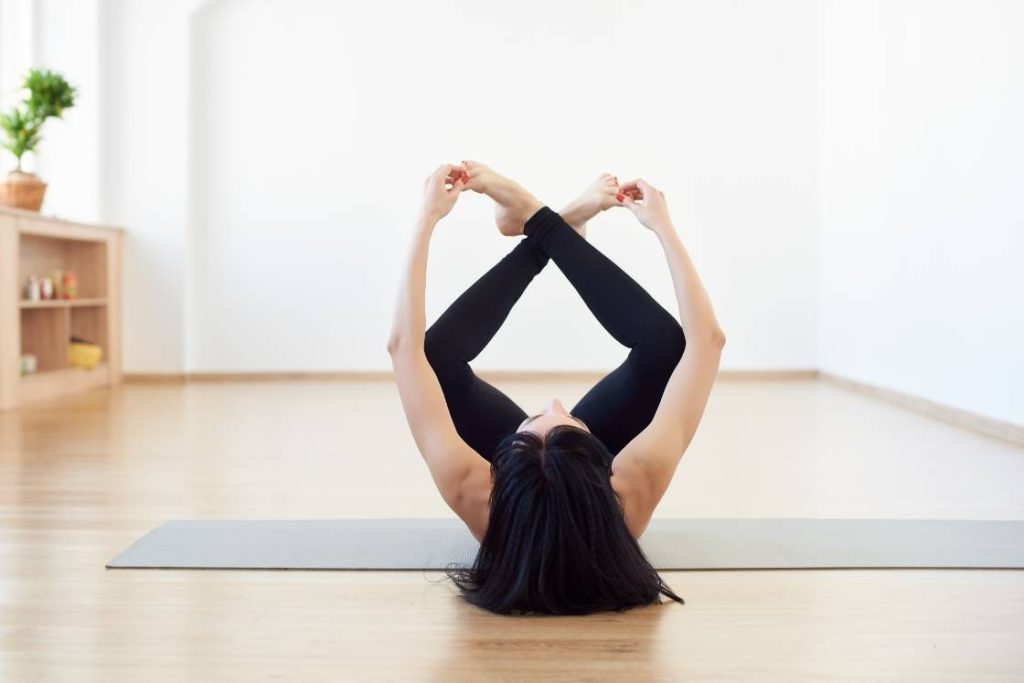
Here, the steps remain the same till opening the knees wider than the torso. This is followed by raising the arms crossing the elbows. Reach the outer edge of your left foot with the right hand and vice-versa.
Remember to listen to your body and modify the variations as needed to suit your comfort level and individual needs. Enjoy exploring these Happy Baby Pose variations and find the one that brings you the most joy and contentment on your yoga journey
Therapeutic Applications
- Happy Baby Pose relieves any muscular tension around the lower back. Therefore, it is remedial to relieve lower back pain.
- It is beneficial to bring calm to the mind. Thus, perform it to release any mental issues like stress, anxiety, etc.
- As of a study in Pain Medicine,
Happy Baby Pose(Ananda balasana) Benefits
1. Stretches and strengthens the hip flexors
Happy Baby Pose is all about opening the hip flexors and releasing all the stress accumulated around this region. The stretching of the hip muscles enhances the blood supply and strengthens them.
2. Stretches the groins, inner thighs, and hamstrings
The position of the lower body is such that the thighs are stretched throughout. It expands the hamstring muscles and stimulates groins. It prepares the body to prevent any injury to these muscles by improving flexibility.
3. Massages the abdominal organs
It is a gentle way of massaging the internal organs. Holding the pose contracts the core muscles and internally the digestive organs are stimulated. It facilitates better digestion.
4. Stimulates kidney
Happy Baby Pose is an effective pose to improve the functioning of the kidneys. It ultimately improves the blood filtration process and removes toxins.
5. Activates the solar plexus and sacral chakra
Happy Baby Pose is a great posture to provide energetic benefits. It opens the Muladhara and Swadhisthana chakra in the body. Activating Muladhara and swadhisthana chakra improves the working reproductive organs. Also, It improves the consciousness and awakens the creative side of the yogi.
Conclusion
Happy baby pose is a yogic posture that allows you to press pause in life and revitalize. It is especially the need of the contemporary world to live a life that is joyful and stress-free.
Therefore, turn the blissful mode on by diving into the divine child present inside us and explore the joy.
